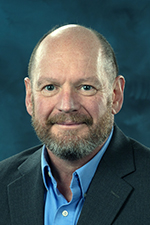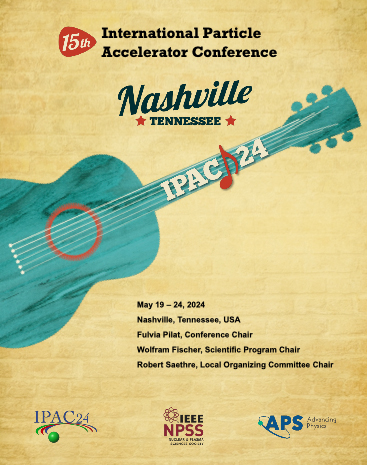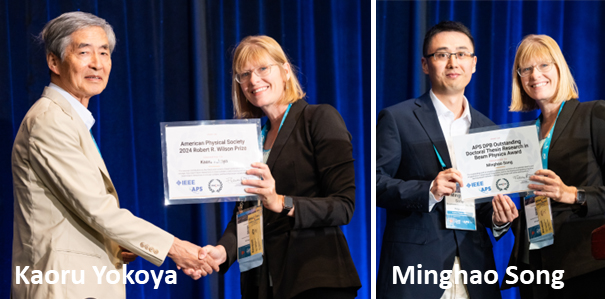Highlights from IPAC’24

The 15th International Particle Accelerator Conference, IPAC’24, took place at the Music City Center in Nashville, Tennessee, USA, from Sunday, May 19th to Friday, May 24th. IPAC’24 offered opportunities for accelerator scientists, engineers, students and vendors to meet and interact while experiencing the charm and attractions of Music City. This fully in-person event featured 1,275 registered participants from 39 different countries — an increase from previous IPACs in the Americas — even though attendance was affected by present global geopolitical issues.
IPAC’24 was sponsored both financially and technically by the Institute of Electrical and Electronics Engineers Nuclear Plasma Sciences Society and the American Physical Society Division of Physics of Beams and was co-hosted by Oak Ridge National Laboratory and Brookhaven National Laboratory. Fulvia Pilat from ORNL was the conference chair, and Wolfram Fischer from BNL was the scientific program committee chair.

Global experts presented pioneering research and development in accelerator technologies. Project leaders discussed new accelerator projects, progress on active upgrades and the operational status of facilities worldwide. Attendees had the chance to network with peers and establish new business contacts.
The Music City Center provided meeting spaces for daily sessions in the Davidson Ballroom and Room 104. The Sunday welcome reception and an industrial exhibition were held in Exhibition Hall A. The Monday morning opening session and Wednesday evening event jointly hosted by Women in Science and Engineering, or WISE, and the journal Physical Review Accelerators and Beams took place at the Broadway Ballroom in the Omni Hotel, which was the conference hotel.
IPAC’24 was attended by 214 students from around the world — 98 of these young scientists and engineers received grants made possible by the sponsorship of various societies, institutes, and laboratories. For the first time, the Nuclear and Plasma Sciences Society awarded 17 early-career travel grants to attend IPAC’24, covering registration, travel, lodging, meals, and incidental expenses. The organizers of IPAC’24 express deep gratitude for this valuable support.





Opening session included opening remarks from Tennessee Economic and Community Development Commissioner Stuart McWhorter (top left) and ORNL Director Stephen Streiffer (bottom left). The conference was opened by Conference Chair Fulvia Pilat (ORNL, bottom right) followed by introductions by Scientific Program Committee Chair Wolfram Fischer (BNL, top right) and Local Organizing Committee Chair Robert Saethre (ORNL, top middle).
The final program included 87 talks, seven invited industry talks and 1,325 posters. A total of 1,040 papers were published on the Joint Accelerator Conferences Website (JACoW). The main classifications included colliders and other particle and nuclear physics, photon sources and electron accelerators, novel particle sources and accelerator techniques, hadron accelerators, beam dynamics and electromagnetic fields, beam instrumentation, controls, feedback and operational aspects, accelerator technologies and sustainability, applications of accelerators, technology transfer, industrial relations, and outreach. Contributions from all three IPAC defined regions — Americas, Asia, and Europe/Middle East/Africa — offered broad and deep knowledge.
Following the welcome reception on Sunday evening, an industrial exhibition took place during the first three days of the conference. A total of 95 industrial exhibitors representing over 100 companies and institutions showcased their high-technology products and services to the delegates. IPAC’s central role as the international marketplace for accelerator business was evident, with many discussions and connections made. The exhibition featured a presentation pavilion where vendors could meet with small groups to discuss their technology and services in a commercial atmosphere.
During the Louis Costrell Awards session, awards were presented to and talks were given by winners of the APS and IEEE Nuclear and Plasma Sciences Society accelerator prizes.

Sarah Cousineau (ORNL) presented the Robert R. Wilson Prize for Achievement in the Physics of Particle Accelerators to Kaoru Yokoya (International Linear Collider) and the APS Outstanding Dissertation Award to Minghao Song (BNL). The APS Courant Outstanding Paper Award went to Pantaleo Raimondi (Fermi National Accelerator Laboratory) and Simone Maria Liuzzo (European Synchrotron Radiation Facility), who were not available to receive the award in person.

Wolfram Fischer presented the IEEE Nuclear and Plasma Sciences Society Particle Accelerator Science and Technology, or PAST, Award to Gennady Stupakov (SLAC National Accelerator Laboratory and xLight Incorporated), the PAST Early Career Award to Agostino Marinelli (SLAC), and the IEEE PAST Doctoral Student Award to Kellen McGee (Facility for Rare Isotope Beams).
Following the talks, APS Fellows, IEEE Senior Members, and the best student posters for IPAC’24 were recognized. Judges selected four winners during a special student poster session on Sunday morning. Kiersten Ruisard (ORNL), Student Awards co-chair, presented awards to Jan-Magnus Christmann (Technische Universität Darmstadt), Madison Howard (Michigan State University), Elena Ros (Arizona State University) and Hannah Hu (University of Chicago).

The WISE event at IPAC’24 was a joint event with Physical Review Accelerators and Beams. A WISE panel discussion featured BNL Director JoAnne Hewett, CERN Director-General Fabiola Gianotti (via videoconference) and National High Magnetic Field Laboratory Director Kathleen Amm (via videoconference). The panel was moderated by Young-Kee Kim, APS president, and Louis Block, distinguished service professor of physics at the University of Chicago. Frank Zimmermann, chief editor of Physical Review Accelerators and Beams, invited papers expanding on original research and topical reviews presented at IPAC’24. Positive feedback from the WISE event’s over 250 participants emphasized the need to strengthen this topic in future IPACs.
The Proceedings Office completed the IPAC’24 pre-press proceedings during the conference, marking a first for a JACoW-edited event. The preliminary edition included all 1,040 submitted papers, which were edited and processed by Friday, May 24th.
A post-conference tour of ORNL, a premier research institution, involved visits to the Spallation Neutron Source, an accelerator-driven user facility, the High Flux Isotope Reactor, the strongest reactor-based neutron source in the United States, and the historic Graphite Reactor.
The success of IPAC’24 was largely attributed to the exceptional collaboration between the international teams in the Organizing Committee, the Scientific Program Committee and the Local Organizing Committee. The LOC included colleagues from ORNL, BNL and Eventive Thinking. The dedication and outstanding efforts of all LOC members are deeply appreciated.
IPAC’24 was the culmination of a significant effort by many, with preparations beginning as early as 2019. The teams adeptly navigated logistical, geopolitical, economic and environmental challenges. The LOC team handled these challenges with remarkable speed and efficiency.
Most importantly, IPAC’24 exists for the benefit of its participants, their work and their enthusiasm. This event relies on the continuous support of various IPAC committees, societies, institutes and laboratories worldwide.
The 16th IPAC will return to Asia and will take place in 2025 in Taipei, Taiwan.
Robert Saethre, PAC’24 Local Organizing Committee Chair, can be reached by E-mail at [email protected]